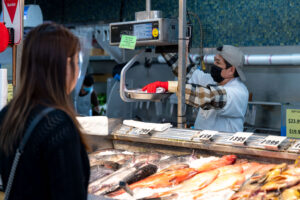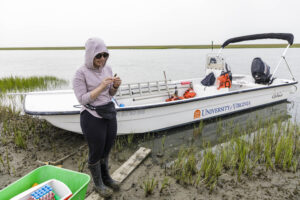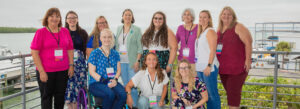'Hooked on OA' Series Shares Latest Science
Ocean waters are becoming more acidic — but how does that affect the Chesapeake Bay? And what does it mean for fish and the people fishing for them?
The ‘Hooked on Ocean Acidification’ webinars answered these questions for mid-Atlantic Anglers in March and April. The four webinars walked through recent research about acidification in coastal waters and out in the open ocean. The webinars were hosted by the Mid-Atlantic Coastal Acidification Network, in collaboration with other mid-Atlantic partners.
In the mid-Atlantic, there are many pieces in the puzzle of acidification
Globally, the oceans absorb carbon dioxide from the atmosphere — and since the industrial revolution, human activities are adding carbon dioxide to the atmosphere 10 times faster than the earth has experienced in the last 50 million years. As the ocean absorbs carbon dioxide, the water becomes more acidic. This effect is known as ocean acidification.
But the effects of acidification aren’t uniform across all water, and the mid-Atlantic region gets its ocean water from several sources, explained Grace Saba, an assistant professor at Rutgers University. The mid-Atlantic continental shelf gets currents of cold water, which can be more acidic, and also warmer, less acidic water from the Gulf stream.
Water acidity also changes from day to day and season to season. During the day, plants and algae near the surface of the water use sunlight for photosynthesis, removing carbon dioxide from the water and converting it to the oxygen. Less carbon dioxide in the water means less acidic water. After dark, plants stop photosynthesizing, and the water becomes more acidic.
The Chesapeake Bay also receives freshwater, which is naturally more acidic. Runoff from land carries nutrients into the water, which can cause algal blooms. These blooms photosynthesize and remove carbon dioxide, making the surface water less acidic. But when the blooms die and sink to the bottom of the water, bacteria break down the algae and create carbon dioxide in the process, making the bottom waters more acidic for crabs and other fish that live there.
Plenty of fish in the sea, but no two fishes are alike
The research on how ocean acidification affects mid-Atlantic fish has just gotten started in the last few decades, explained Hannes Baumann, an associate professor at the University of Connecticut. Of the 20,000 marine fish species in the world, researchers have only studied how 60 of them will respond to the stress of acidification.
Part of the challenge is that similar fish don’t always react similarly to acidification, so it’s harder for researchers to make blanket statements about groups of fish, Baumann said. But based on the research so far, most juvenile and adult fish are likely to survive, but freshly hatched fish are much more vulnerable to the effects of acidification.
Some fish live in waters that already experience fluxes in acidity from day to day, and are well-adapted to survive in these conditions. But other fish, who live where water acidity doesn’t change as much, may not be able to adapt fast enough.
Also, acidification can make other stressful conditions like low oxygen and warmer temperatures worse for fish, similar to how two medicines can cause harmful side effects when taken together.
“This is one of the chief concerns we have about acidification and low oxygen in coastal environments — that together, they really make it worse,” Baumann said.
Is seagrass a solution for the Chesapeake Bay?
During the day, seagrass and algae in the Bay are hard at work taking carbon dioxide in the water and converting it into oxygen. As they do this, they change the water chemistry nearby and make it less acidic. That might be good news for shellfish like clams and oysters, which depend on calcium carbonate to build their shells. In more acidic waters, less calcium carbonate is available for the shellfish to use, and the acidity can weaken the shells they’ve already built.
Weakened shells leave the oysters more vulnerable to predators. At very high levels, the acidity could reach the point where oysters don’t have enough energy to build shells, feed themselves, and reproduce. But nearby seagrass could help relieve stress for oysters by reducing the water’s acidity.
“The missing link is: Will it be enough that we will actually see a measurable benefit to the oysters? We need to know the oysters’ tipping point first,” said Emily Rivest, an assistant professor at the Virginia Institute of Marine Science (VIMS).
Photo by Will Parson | Chesapeake Bay Program
Rivest and a team of researchers studied how oysters respond to the stress of acidic conditions for six-month-old and two-year-old oysters. They measured oyster survival, their shell-building, waste production, and feeding. They found that the two-year-old oysters’ shells started to dissolve faster. Rivest said this may be because parasites burrow into the shells, and these bumps and craters in the shell leave more of it exposed to acidic water.
These results will be incorporated into a model of how seagrasses affect water chemistry. The model uses mathematical equations to estimate how different water qualities, seagrass beds, and oyster reefs interact to find the “magical combination” that would be most helpful for oysters.
By showing how oysters respond to the stress of acidification, the research indicates where the best water conditions are for oyster aquaculture, or where seagrass beds would be most helpful, Rivest explained.
Forecasting ocean acidification in the Bay
Unlike adult oysters, finfish that are stressed by low oxygen or water acidity can move to better areas. Anglers check the tides and weather forecasts before they head out to the water, but new research at VIMS will also allow them to check the forecasted water quality near their fishing spots.
Forecasting acidity in the Chesapeake Bay can be complicated because multiple factors influence acidity. For example, water from tidal rivers bring nutrients, freshwater, and sediment in to the Bay — all of which can affect acidity. Fei Da, a Ph.D. Student at VIMS, is working to improve water quality forecasts in the Chesapeake Bay.
But to predict how water conditions will change, researchers must first understand which factors cause the most change to water acidity. Da found that over the past 30 years, carbon dioxide from the atmosphere and nutrients like nitrogen cause the biggest changes in acidity.
The model factors in temperature, precipitation, humidity, wind, fresh water from rivers, nutrient flow, and ocean fluxes. Based on these conditions, the model creates a two-day forecast for salinity, acidity, and temperature across the Bay. Now, researchers are working to add detail to the model so that people can zoom in on forecasts for more specific areas.
“One of the goals of this system is to provide information that may be used to make decisions about where to fish,” Da said.
The research on how ocean acidification affects mid-Atlantic fish has just gotten started in the last few decades.
Takeaways:
- Ocean acidification is occurring together with other stressors, such as low dissolved oxygen and warming temperatures, and can cause an additional layer of stress for fish.
- In the mid-Atlantic, researchers have studied how 18 different species of fish might respond to ocean acidification. The majority of those species experienced some type of negative effect.
- Fish embryos are more vulnerable to the effects of acidification than juvenile and adult fish.
- Seagrass beds can help decrease acidity, since their photosynthesis removes carbon dioxide from the water.
- Over the past 30 years, carbon dioxide from the atmosphere and nutrients like nitrogen cause the biggest changes in acidity.
To view the full webinars, visit the Mid-Atlantic Coastal Acidification Network website here.
Hooked on Ocean Acidification was sponsored by the Mid-Atlantic Coastal Acidification Network (MACAN) and the Mid-Atlantic Regional Association for Coastal Ocean Observing Systems (MARACOOS), in collaboration with our partners at the Virginia Institute of Marine Science, Rutgers Cooperative Extension, the Mid-Atlantic Regional Council on the Ocean (MARCO), and the New Jersey Sea Grant Consortium.
Story and design by Madeleine Jepsen | Virginia Sea Grant
Photos by Aileen Devlin | Virginia Sea GrantPublished June 18, 2021.
“This is one of the chief concerns we have about acidification and low oxygen in coastal environments — that together, they really make it worse,” Baumann said.





